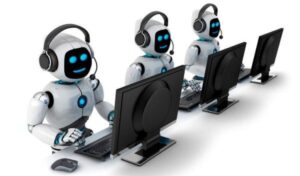Robots. They have been around for a while now. For decades, we have watched as they gradually increase in numbers and in importance. We have managed to live peacefully with them all this while. But this peaceful co-existence can be traced to the reality that the current relationship we have with them is more of a master and servant relationship. We created them and put them to use in various ways all in an attempt to make our lives a little easier. Many experts have argued that the use of robots is nothing but an extension or upgrade of the generally accepted concept of self-service.
There used to be a time when robots were nothing but almost hollow metallic containers trying to mimic humankind. That was before the days of Artificial Intelligence. AI has pushed the envelope so far that the robots of today are no more the robots of yesteryears. AI has truly made robots the autonomous beings that the original thinkers had in mind. The infusion of the ability to respond to emotions is one of the game-changing moments in the evolution of robots. Knowing the importance of emotions when dealing with customers, this capacity of modern robots will truly change the narrative regarding robots.
One group of robots has been making waves for some time now. These are the Service Robots—those that interact, communicate and deliver service to customers. Employed for various uses, these automated helpers come in various shapes and forms. Those that come fully designed with faces, feet and hands are referred to as Humanoid Service Robots or HSRs. Then there are those who exist only virtually. You might be able to touch them but they are very much robots in every sense of the word.
Service robots of whatever form are currently being used to undertake tasks such as delivering goods, cleaning of buildings, disinfecting of spaces and even some are used to undertake complex medical procedures. Some of these robots, such as Alexa and Siri, are even being used as virtual assistants. They are literally running the lives of people.
For now, the relationship between humans and robots will remain the same. We would put them to use as a when we so choose to and when we can afford to. However, the rate at which robots are being manufactured and employed in various settings means that it is only a matter of time before they begin to ‘take over’.
By ‘take over’ I do not mean in the military coup d’état sense such as scarily portrayed in the Hollywood blockbuster, I, Robot. I mean ‘take over’ as in being ubiquitous, being everywhere. That is the life we should all be preparing for because it is not as far away as many of us seem to think. The days of the robot ‘invasion’ are just around the corner. So long as service robots are in full operation in any part of this world, it is only a matter of time before their presence is felt across the length and breadth of this globe.
When the robots take over, at least one of your colleagues at work will most likely be a robot. This will make the work environment quite interesting. For one, your colleague – the robot, will not get tired as you would. The robot will not take time to go for lunch. The robot will not even give you an ear when you attempt to gossip with it. As earlier mentioned, tomorrow’s robot will even be able to smile. This means that if you refuse to keep a pleasant demeanour as a customer-facing professional, your robot colleague will ensure that you are all on your own. In short, if you do not get your act together, you could easily be replaced by the robot next to you.
Having robots and humans working side by side to serve customers is such a reality that there are even studies to find out how humans will interact with collaborative service robots at the workplace. One such study, titled: ‘My colleague is a robot – exploring frontline employees’ willingness to work with collaborative service robots’, was published in the November 2021 edition of the Journal of Service Management.
The study sought to find out, among other things, the willingness of humans to collaborate with robots. One of the interesting findings from that study was the different classes of employees categorised with regards to how they would engage their non-human colleagues. The study found that there were four different personas among employees as to how they will work with robots. The four categories of employees are as follows:
Supporters: These are employees who have absolutely no problem with having robots as colleagues at work. However, for this group, the robot should only do the tedious, boring and repetitive work while the human still takes control of all other decisions. In other words, for the supporter, the robot is still just a tool.
Embracers: This group is made up of those individuals who truly appreciate the benefits of having robots as work colleagues. They understand the unique skillsets that robots bring into the workplace and would happily put those skills to use for the good of the organisation and the customer’s experience.
Resisters: These are those with a very negative disposition toward robots. They will go to great lengths to warn about the implementation of such technology in the workplace. These individuals might even refuse to collaborate with their non-human colleagues.
Saboteurs: These are those who will take their distaste for robots to the next level. They will not only refuse to work with these robots but will even sabotage the technology just to make their point.
The truth is that each and every one of us has his/her own preconceived notions about working with robots. For now, because we are not having to work with them, all seem to be calm. But trust that the day you go to work and you are introduced to a robot as your co-worker, your real attitude and feeling toward robots as workplace colleagues will come out.
When the robots take over, your next customer might even be a robot, an AI. Whenever we talk of customer service, we have always assumed that the customer is a human. However, with the rapid proliferation of truly autonomous robots, one should not be surprised to find oneself serving a robot. Case in point are self-driving cars. These are nothing but robots on wheels. We are told that these machines have a capability to detect any problems within their systems and to order for replacement parts all on their own. In other words, the voice you might hear on the phone ordering new car batteries could well be an AI customer, not a human.
When robots take over, your customer-facing service employee might be a robot. We have already touched on the importance of service robots, and this importance will only continue to grow. As far back as 2014, Japanese mobile telecom and investment giant SoftBank Group introduced the Japanese public to a robot that could chat with customers and collect their opinions. This chatty robot was named PEPPER.
Moving around on rollers, the 120cm (4ft) tall PEPPER would approach customers as they entered the shop and begin to converse with them. PEPPER could even dance and tell stories. The makers were convinced that being a robot meant that PEPPER was able to attract the attention of more shoppers, who found it interesting to be having a conversation with a non-human. As an addition, the makers claimed that PEPPER could even read the emotions of those it was conversing with.
A year after the unveiling of PEPPER, Riken Research Institute – also in Japan, unveiled a bear-shaped nursing robot. ROBEAR, as it is known, is able to lift patients out of their beds and into wheelchairs. ROBEAR is also able to help those elderly people who need assistance to stand up. According to the manufacturers, ROBEAR is to help nurses and other caregivers who go through a lot of stress to take care of the elderly.
Robots are already doing some great jobs in restaurants around the world. In Japan, Connected Robotics has pioneered robots which can help in the kitchen. They have a robot that is able to cook a meal made of buckwheat. The buckwheat robot is able to boil the grains at a uniform temperature, remove whatever slime comes out and add more water when needed. All that the human chef needs to do is to add a touch of creativity to the meal.
Connected Robotics also has a robot specifically designed to cook French fries. This particular robot is able to go for the potatoes, put them in a basket, and put the basket of potatoes into a deep fryer. The robot then automatically fries the potatoes at an even temperature by shaking the basket at a uniform pace. When it is done with the frying, the robot will drain the oil from the fried potatoes and carry the fries to a bagging station, where the human counterpart adds the seasoning and other finishing touches. The food can then be served to customers.
Beyond cooking and being of help behind the scenes, robots are also coming into the customer service areas. QBIT Robotics, another Japanese firm, has already pioneered this technology where a robot is able to bring food from a salad bar straight to the customer’s table. Connected Robotics, which was founded barely a decade ago, even has a robot that serves ice cream as it chats, sings and makes faces at customers. The ice cream robot has a built in sensor and camera that is able to detect the position of a customer, so it is able to turn and face the direction of the customer, as it converses with the one.
TO BE CONTINUED











